The Collegiate Chorale: The Road of Promise
Reflections on an uneven performance, a problematic musical work and the use of art as an instrument of moral persuasion and political ideology.
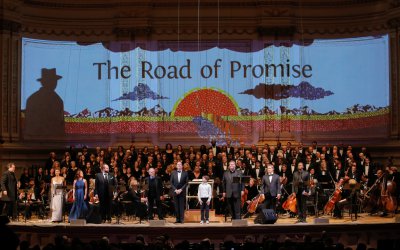
The finale of “The Road of Promise” as performed by The Collegiate Chorale at Carnegie Hall (May 6 and 7, 2015) (Photo credit: Erin Baiano)
[avatar user=”Jean Ballard Terepka” size=”96″ align=”left” ] Jean Ballard Terepka, Music Critic[/avatar] On May 6 and May 7, 2015 at Carnegie Hall, presenting a concert version of Franz Werfel and Kurt Weill’s 1937 The Road of Promise, (Der Weg der Verheissung), The Collegiate Chorale conducted and directed by Ted Sperling undertook a near-daring project … and failed. The performance was uneven at best. The work was more interesting for its problems than its ultimate beauty or success.
The musical and artistic intentions of the project were never in question; the integrity of The Collegiate Chorale, an institution that continues to hold an important place in the complex, competitive world of New York City classical choral music, was never jeopardized. But the overall failure of the project, reported on, though briefly and kindly, in several prominent reviews, was nonetheless significant.
Examination of the simultaneous failure and integrity of the project raises important, interconnected general questions about the history of music and the use of the creative arts on behalf of social and political conscience; it also provides an opportunity to examine this genuinely interesting and deeply flawed piece of music.
Performed 153 times in New York City in the early winter months of 1937, The Road of Promise was originally a four act extravaganza – a pageant, a spectacle – that took several hours to perform and would ultimately lead its producer to crippling bankruptcy. After it closed, the work was essentially forgotten and much of its score lost; detailed accounts of its staging, whether witnessed or remembered, were confused and contradictory.
Around the time of the 2000 centenary of Kurt Weill’s birth, various German and American conductors, musicians and scholars became interested in reviving the work; there were indeed several productions of varying success – and length – in Germany and here in New York. Composer and then director of the Kurt Weill Foundation, Ed Harsh, having been interested in The Road of Promise since as early as 1996, embarked upon the project of condensing the mammoth score into a two act concert adaptation. The two performances of The Road of Promise, on May 6 and May 7, 2015 constituted the United States premiere of Harsh’s Werfel-Weill Road of Promise.
In this version, though the work is cut by much more than half, the original structure is maintained.
Propelled by anxiety and fear in the violent attacks against them, several Jews in an unnamed German city gather for protection and comfort in a synagogue; the wise and kindly Rabbi tells Bible stories while a thirteen-year-old boy, only dimly aware of his heritage, learns what it means to be a Jew. The original many Synagogue characters of the four-act pageant are pared down in this version to merely three, the Rabbi, the Boy and a complex and savvy man, a worldly-wise secular Jew, called ambiguously The Adversary. The Rabbi, the Boy and the Adversary have spoken parts; in Carnegie Hall, they were miked (unlike the singers) and their voices carried differently from the singers’ within the hall.
The Boy was played with energetic, earnest presence and maturity by Eli Tokash; no amount of thoughtful direction, however, could make The Boy a genuinely human character. In Werfel’s script, the character functions more as a multifaceted symbol awkwardly representing, at any given moment, loss of innocence (the young man’s; Jews’; Americans’), a bar mitzvah coming of age and acquiring wisdom, a reliable prompt for questions for the Rabbi and a foil to The Adversary’s weary cynicism. The Boy’s stiff and thoroughly unbelievable divination of important meaning – “And so I am all Jews?” (within the first third of the piece) – is typical of the libretto’s lack of psychological insight or credible emotional development.
The Rabbi does his best to both comfort and enlighten. He is grandfatherly and kind with The Boy. He is sturdy and brave with The Adversary. He certainly knows his Bible; he chooses appropriate stories to illuminate themes of exile and cruelty on the one hand and God’s steadfast love and salvation on the other. Anthony Dean Griffey’s Rabbi was appealing in his characterizations, especially in his interactions with The Boy, but his material, like the Boy’s, was stiff and unnuanced.
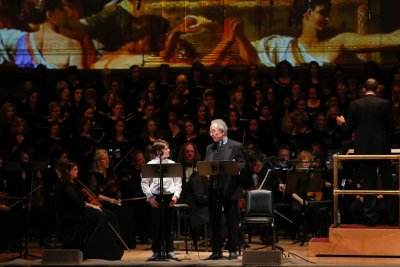
Eli Tokash as The Thirteen Year-Old Boy and Ron Rifkin as The Adversary in a scene from The Collegiate Chorale’s performance of “The Road of Promise” (Photo credit: Erin Baiano)
Well-known actor Ron Rifkin played The Adversary. Usually audible, Rifkin played his part, certainly the most satisfyingly complex in the whole work, with dynamic vigor and conviction. Rifkin even managed to elicit some nuance from his role, brusquely tolerating the Rabbi and demonstrating an almost involuntary tenderness toward the Boy.
The Synagogue story, while standing in some senses as a self-contained narrative, also functions as a frame for the Bible narratives, the examination of the prophecies of Jeremiah, and warnings about both perennial and contemporary anti-Semitism.
The ancient sacred stories – the men’s: Abraham’s, Moses’, David’s, Joseph’s, and the women’s: Naomi’s, Miriam’s and Ruth’s – are presented in the libretto in an awkward combination of sung and spoken narration, choral singing and individual soloists’ singing, in duets or with the chorus. Here, where clarity would have been most useful, The Collegiate Chorale production’s weaknesses were most manifest.
Whether because of the original libretto or the Harsh revisions, the Biblical characters’ stories and songs felt truncated or confusing; links from one story to the next were awkward and unclear. The fact that some of the singers simply could not be heard, especially when singing with the both chorus and orchestra, increased the sense of conceptual blur.
Weill’s music, throughout the work, is curiously incoherent. Deliberate but unsatisfying echoes of Bach, Mozart and sweeping Romantic symphonies, masses and requiems punctuate the score’s disconcerting blandness, an apparent attempt at accessibility that felt like an evisceration of Weill’s identifiable earlier energy. The Jewish elements of the score were curiously submerged: Weill’s use of some identifiable German-Jewish centorial melodies, devoid of almost all folk music references, seemed compromised by his emphasis on undemanding homogeneity.
It should be said, in fairness, that throughout the course of the evening, there were, in spite of the concert’s difficulties, some beautiful moments. The duet of Jacob (AJ Glueckert) and Rachel (Lauren Michelle) was lovely: Glueckert and Michelle’s voices were well matched and they sang sensitively with each other. Mezzo-soprano Megan Marino was very fine throughout; her Ruth was credible and intensely felt. Philip Cutlip as the wise prophet Jeremiah was compelling.
The usually reliable, disciplined Collegiate Chorale, atypically, seemed to have occasional trouble maintaining its footing. Some choruses were ragged; tenors had periodic difficulty finding their pitch; altos and sopranos operated at cross purposes. Reassuringly, the grand choral conclusions of both acts were well crafted, hearty … and beautiful. The Orchestra of St. Luke’s, normally so satisfyingly clean, seemed insecure; entrances were unpredictable and rhythms unreliable. Balance issues during soloists’ arias were particularly tricky – soloists were often drowned out by the orchestra – though when chorus and orchestra were performing together without soloists, these problems virtually disappeared.
The single oddest musical element of the evening was the Voice of God. At key points, as God’s presence proved necessary for the cosmic story’s march towards safety and salvation, his pre-recorded, rather blustery tenor Voice materialized. In the program, the singer was listed as “Anonymous.” What on earth was this all about? The questions raised by the anonymity puzzle were distracting and confusing; the Voice was not in any sense divine enough to either outweigh or outshine the silliness of the puzzle.
The most frustrating failure of the evening lay in Wendall K. Harrington’s video projections, probably intended to evoke the ambitious scope and dramatic effects of the original 1937 Road of Promise production. Projected onto the back wall of Carnegie’s Isacc Stern Auditorium/Ronald O. Perelman Stage, whose three panels created something of a triptych effect, were gorgeous images of some of the Bible narrative episodes being presented by the performers. Some of these images were familiar, and some less well known; audience members, pooling their knowledge between acts or after the performance, identified the works of artists as varied as William Blake, Ben Shahn, the Soyer brothers and Marc Chagall. Unhappily, nowhere were the works identified. Superimposed on the images were the texts of some of the sung numbers … some, but not all … and there seemed no rhyme or reason to explain which arias or choruses received the (welcome) benefit of text and which didn’t.
At the very end of the whole work, as the images presented conveyed luminous and golden heavenly glory, texts in Hebrew scrolled up along the wall. Non-Hebrew-reading audience members – no doubt the majority of the audience – were left to wonder what the texts were: Genesis I? the Ten Commandments? Psalm 26 (from which most of the text of the final chorus was adapted)? Audience members also noted that the heavenwards scrolling text, proceeding up along the back wall as the orchestra and chorus sang triumphantly of God’s redemption, looked alarmingly like 1940’s Hollywood wartime morale-boosting films’ scrolling credits soaring up into the wild and patriotic blue yonder.
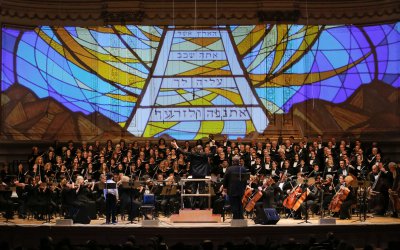
A scene from The Collegiate Chorale’s concert performance of Kurt Weill’s “The Road of Promise” (Photo credit: Erin Baiano)
Making sense of a disappointing evening such as this is important for at least two reasons.
First, those who undertake the intellectually heroic project of reclaiming historically complex pieces of music such as this should not be discouraged from continuing to do so.
Second, disappointed audiences, leaning on the assumption that that which has been forgotten has probably fallen into that sad state for good reason, should not leap to condemnation of reclamation projects and seek thereby to remain comfortable with the securely familiar.
The Road of Promise was a troubled work in its very origins and throughout the whole of its brief 1937 production life.
The work began as a response to a perceived need to publicize the plight of Jews in Nazi Europe; it was the brainchild of Meyer W. Weisgal (1895-1977).
A Polish Jew who immigrated to this country as a boy, Weisgal studied journalism at Columbia University and served in the United States Army in World War I. A Zionist from the middle of the Great War until the end of his long, productive life, Wisegal became the master, between the wars, of grand moral and political propagandist spectacles. In 1932, Weisgal mounted Israel Reborn, an All-Chicago Hanukka Festival, followed by the Zionist Romance of a People the next year at the Chicago World’s Fair; six years later, eighteen months after The Road of Promise, Weisgal designed the Palestinian Pavilion at the New York World’s Fair, designated as a “national display,” even as the foundation of Israel still remained a full decade away.
For the great morality play, the “Jewish oratorio” that would become The Road of Promise, warning Americans of the dangers facing Jews in Europe and promoting the vision of a Zionist state, Weisgal turned to the renowned theatrical director Max Reinhardt (1873-1943) who had recently fled Germany in response to newly imposed Nazi policies that expelled Jews from participation in the performing arts.
Reinhardt in turn suggested two prominent Jewish artists for the project, men who were newly refugees, like Reinhardt, from their homes in Europe: Franz Werfel (1890-1945) would write a libretto and Kurt Weill (1900-1950) would set it to music. Both choices had elements of risk to them.
Austrian-Bohemian playwright and novelist Werfel, though Jewish, had felt the pull of Catholicism and its mystical traditions all his life; his attempts at theological and psychological reconciliation of Judaism and Catholicism are evident in his 1928 play Paul Among the Jews (Paulus unten der Juden). To this day, as Werfel’s reputation has declined, he is much better known for his novel and subsequent Academy Award-winning 1943 movie, The Song of Bernadette (Das Lied der Bernadette), about the simple peasant woman who made Lourdes famous, than his compelling 1933 The Forty Days of Musa Dagh (Die vierzig Tage des Musa Dagh) about the Turkish massacre of Armenian Christians during World War I.
Werfel’s approach to Weisgal’s project of sounding the call against anti-Semitism and championing Zionism was historically based: his libretto focuses on those Torah stories that foreshadow salvation in God’s Promised Land, expounds on Jeremiah’s prophecies, and envisions the realization of hope at a time when the enemies of the Jews will be vanquished forever. The near-mystical certainty that God will never abandon those who love him and the optimism of a salvational eschatology were, from the beginning, at odds with the growing dark horrors facing Jews and the unspiritual, tough political grit required to consider creating a Zionist state.
Reinhardt’s suggestion for a composer was almost as surprising as for a librettist. Kurt Weill had only recently left Germany; his artistic reputation was solid, but not that much of his music had actually been heard in this country.
Together, Werfel and Weill did constitute a formidable pair of artists whose Jewish identity in one way or another was central to their work: they seemed like the perfect team to create a persuasive work of art that would be, as Weisgal constantly reminded them, entirely Jewish, providing a Jewish perspective on a Jewish subject so compellingly, forcefully and effectively that everyone – Jew and non-Jew alike – would understand the complex and urgent issues.
The Road of Promise was conceived on a grand scale, both for its own sake and for the tastes of an American public now accustomed to everything from Busby Berkeley extravaganzas, to the wild grandeurs of opera at the Hollywood Bowl to the bizarre Mormon adaptation of medieval traveling Passion Plays, The Hill Cumorah Pageant, premiered in Palmyra, New York, in the same year as The Road of Promise (and still performed annually). The entire interior of Oscar Hammerstein’s original Manhattan Opera House at 311 West 34th Street was gutted to create room for the project’s moving platforms and stages; more than 1,000 stage lights of different sorts and over 25 miles of new electrical wire were installed. Because the orchestra pit had been turned into the theater location for the Synagogue, a handful of musicians played live music from off-stage, accompanying piped-in recordings of Leopold Stowkowski’s Philadelphia Orchestra rendering the more complex and demanding musical passages. The lavish set design was conceived and overseen by futurist Normal Bel Geddes. The New York Times reviewer described the entire set as “an enormous series of ramps and platforms that rise in supplication to the portals of heaven.”
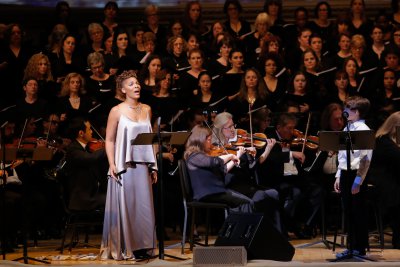
Megan Marino who sang the roles of Miriam and Ruth in “The Road of Promise” by Kurt Weill, May 6 and 7, 2015 (Photo credit: Erin Baiano)
Almost 250 actors, actresses and singers took part in every performance; innovative dance sequences were choreographed by Polish-Jewish dancer, and later filmmaker, Benjamin Zemach (1901-1997), who specialized in the adaptation of traditional Jewish folk dance steps into exciting, demanding modern dance. Over 1,700 costumes were designed and fabricated; the scenery was lavish.
The completed four act work lasted somewhere between three and five hours; critics were never able to review the end of the work because of their deadlines. Libretto and score were constantly being fiddled with to address production problems; each performance – even though almost all 153 of them were sold out – was a staggeringly large money-losing proposition; the final performance was a fundraiser for Meyer Weisgal.
Reinhardt had telegraphed Weisgal, “The light that we lit together in the Manhattan Opera House will shine undimmed in the history of the theater and of the Jewish people.”
But, in fact, the work was thereafter abandoned. Unperformed and unperformable, the huge production and the passionate vision that created it rapidly became the material of memory; until the end of the twentieth century, no revival of the work was ever even considered.
This was the state of things until planning for the Kurt Weill Centennial began at the end of the twentieth and the beginning of the twenty-first centuries here in the United States and in Germany. Adaptations of The Road of Promise were mounted in Germany in 1998 and here in New York City in 2000; in both cases, the performances were extremely long and received mixed reviews. And then, composer and scholar Ed Harsh, at that time director of the Kurt Weill Institute, enamored of The Road of Promise and its history since at least 1996, turned his considerable energies to creating a manageable, reasonably sized revisiting and revision of the work.
The long-range result of this dedicated, disciplined and insightful project, funded in part by the Kurt Weill Foundation for Music, Inc. and the National Endowment for the Arts, was the premiere of a German version in Dessau, Germany in February, 2013, and then the English version, premiered May 2015 with The Collegiate Chorale. The Collegiate Chorale has a well-established history of commitment to the works of Kurt Weill. In February, 2003, then Collegiate Chorale music director Robert Bass conducted the Chorale, Bebe Neuwirth and Roger Rees in “An Evening of Kurt Weill.” Bass noted at the time, “Weill’s broad range of styles makes him a composer ideally suited to the Collegiate Chorale’s mission of exploring the full spectrum of the vocal arts.” In addition, it performed concert stagings of The Firebrand of Florence in 2009 and Knickerbocker Holiday in 2011, both of which were recorded.
Before the May 7 performance of The Road of Promise, Ed Harsh and Ted Sperling, the current Collegiate Chorale artistic director, met together for a pre-concert talk with interested audience members. Though their presentation was driven from the beginning by audience questions rather than a formal outline, the depth of Harsh’s love of this material and Sperling’s thoughtful determination to do it justice were clear. For those who were especially interested in either the Werfel/Weill piece or The Collegiate Chorale, The Collegiate Chorale website had already provided an exceptionally detailed, clear and well done three-part blog on the “Genesis, Creation and Realization of The Road of Promise.” In their conversation with the audience, the depth of Harsh and Sperling’s collaborative commitment to the success of this endeavor was both evident and exciting.
Beyond the musical and intellectual interest in the work, Harsh and Sperling made reference, both oblique and explicit, to the current climate of increasing racial and ethnic prejudices, including anti-Semitism, in this country and in Europe, and to the ongoing, urgent need for moral and political conscience in the face of this racism.
Harsh and Sperling are, of course, right.
But the 2015 Road of Promise is no more successful in sounding a substantive alarm about anti-Semitic and racial injustices than the 1937 production was.
Significant problems inherent in the original work militated against its ability to be effective in the achievement of Weisgal’s primary goals: the very universality of the plight of the Jews, the element of the story most designed to appeal to all people of all backgrounds, emphasized and illuminated by both Werfel and Weill, ended up diluting the crucial particularity of the contemporary European threats to Jews. The explicit urgency of Zionist purpose became submerged in a grand mystical vision – legible to American audiences as something comfortably familiar … and Christian – of safety and salvation, redemption and security.
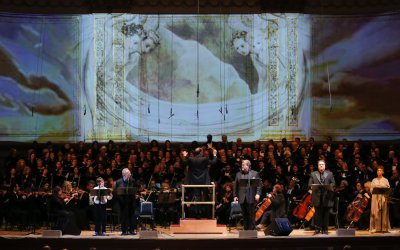
Maestro Ted Sperling with the Orchestra of St. Luke’s and the Cast of The Collegiate Chorale’s “The Road of Promise” (Photo credit: Erin Baiano)
Even in the sophisticated and cosmopolitan political climate of New York City between the wars, the Zionist message of The Road of Promise was quite lost. Simultaneously and even more fundamentally, in the late 1930’s moral denial about Nazism’s dangers that permeated most of American society, the triumphant – and positive – conclusion of The Road of Promise permitted short-sighted, uncourageous complacency in the face of peril.
These factors – together with the outrageous, impossible expense of the production – doomed the project to a peculiar failure that was both musical and political in nature.
One wonders: What might have been the internal intellectual and emotional experiences of 1937 audience members years later as they remembered the strange, sprawling pageant in light of the terrible knowledge of the actual events of the Holocaust? Now, three-quarters of a century after The Road of Promise brief 153-performance run and more than half a century after the Second World War’s conclusion, a 2015 audience perceives the murky premonitions of The Road of Promise through the memory of Holocaust realities with sympathy and respect. The lack of success of the work’s original Zionist message can be responded to with either regret or relief, depending on one’s response to current Israeli policies about an independent Palestinian state.
Our current 2015 perspective is multilayered. As with any historical revision, an insightful audience hears the work “twice”: they hear it in their own present time and they imagine hearing it as an original audience might have. 2015 sensibilities shape present interpretation and historical imagination. In its “double” hearing, the May, 2015 audience witnessed both the original work – its 1937 weaknesses weirdly preserved, in addition to its strengths, in Harsh’s carefully loving and thoughtful condensation and adaptation of the original – and the 2015 performance flaws.
The restoration of this work had scholarly elegance to it. The decision to perform the work seems to have come from a great and respectful love of it. But a concert-style performance in Carnegie Hall was somehow off the mark. The Road of Promise is an important cultural and political artifact; the complex story of its conception, planning and execution – the very topics covered in The Collegiate Chorale blog – provides a rare lens through which to consider major overlapping social, intellectual, commercial and artistic narratives in American cultural history. The Carnegie Hall concert-style performance, with Harrington’s attempted evocation of theatrical grandeur by means of images of great art, was an awkward way of analyzing and honoring a theatrical and musical artifact.
A better solution to the appropriate desire to share The Road of Promise might have been in an academic setting, combining performance elements with seminar conversations around such subjects as Werfel’s text, the fascinating 1937 production history, the diverse and divergent sources and inspirations for Weill’s score, The Road of Promise music as a transition piece between Weill’s European and his American compositions, and the place of The Road of Promise within the rich traditions of huge American public pageants.
The need for ongoing urgent alarms about the many forms of racism that persist in our world is as critical now as it was in 1937. Though the warnings about anti-Semitism in The Road of Promise proved inadequate, the 2015 decision to honor the work’s intentions and its history should nonetheless inspire contemporary creative artists and their audiences to confront racism’s evils with determination and zeal and to acknowledge with gratitude all those who have tried to do so in the past.
For more information on The Collegiate Chorale and its May 2015 production of The Road of Promise, see http://www.collegiatechorale.org. For more information on The Road of Promise, see The Kurt Weill Foundation for Music at http://www.kwf.org and the Seth Milken Archive of Jewish Music at http://www.milkenarchive.org.






Leave a comment